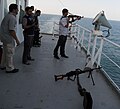Portal:Piracy
Introduction

Piracy is an act of robbery or criminal violence by ship or boat-borne attackers upon another ship or a coastal area, typically with the goal of stealing cargo and other valuable goods. Those who conduct acts of piracy are called pirates, and vessels used for piracy are called pirate ships. The earliest documented instances of piracy were in the 14th century BC, when the Sea Peoples, a group of ocean raiders, attacked the ships of the Aegean and Mediterranean civilisations. Narrow channels which funnel shipping into predictable routes have long created opportunities for piracy, as well as for privateering and commerce raiding.
Historic examples of such areas include the waters of Gibraltar, the Strait of Malacca, Madagascar, the Gulf of Aden, and the English Channel, whose geographic structures facilitated pirate attacks. The term piracy generally refers to maritime piracy, although the term has been generalized to refer to acts committed on land, in the air, on computer networks, and (in science fiction) outer space. Piracy usually excludes crimes committed by the perpetrator on their own vessel (e.g. theft), as well as privateering, which implies authorization by a state government.
Piracy or pirating is the name of a specific crime under customary international law and also the name of a number of crimes under the municipal law of a number of states. In the 21st century, seaborne piracy against transport vessels remains a significant issue, with estimated worldwide losses of US$25 billion in 2023, increased from US$16 billion in 2004. (Full article...)
Selected biography -

Kristoffer Throndsen (c. 1500–1565), posthumously also with the family name Rustung, was a squire, admiral, feudal overlord in Norway and Denmark, privateer captain and pirate. Kristoffer served Archbishop Olav Engelbrektsson, the interregnum leader of Norway, in the last years of the Kalmar Union.
Kristoffer is famous for playing a role in the last years before the Reformation in Norway, first as the head of the national fleet, defending Norway from attacking Danish ships; and also as the murderer of Vincent Lunge, a Danish nobleman sent to Bergen in 1536 to enforce the choice the King of Denmark Christian III as king of Norway. This dramatic moment in Norwegian history is memorialized today in an annual "midnight opera" sponsored by the Norwegian Ministry of Culture. Titled Olav Engelbrektsson, it takes place on the premises of the castle, outside Trondheim. (Full article...)
Selected article -
Pirate studies is an interdisciplinary field of academic study typically using historical and literary techniques to understand piracy and its cultural connotations.
C.R. Pennell in Who Needs Pirate Heroes? documents the evolution of Pirate Studies. He argues that the first academic historians using properly historical techniques such as archival sources began to examine piracy around the late nineteenth and early twentieth centuries. In this context Penell mentions two works: Stanley Lane-Poole's The Barbary Corsairs (1890) and C.H. Haring's Buccaneers in the West Indies in the Seventeenth Century (1910). But the growth and respectability of the academic study was significantly aided by the work of Professor John Bromley, the British maritime historian. A collection of this work was published as J.S. Bromley, Corsairs and Navies, 1660–1760 (1987). By the end of 1990s much of the work in Pirate studies, Pennell notes, could be grouped under three headings: the economics of piracy, the political and ideological importance of piracy, and women pirates. (Full article...)
Did you know?
- ... that Pixel Piracy's developers released a free torrent of their game?
- ... that Black Sheep Radio dedicated its first day of programming to a fallen pirate?
- ... that a search engine for pirated books has been used to train large language models?
- ... that since 1904 the Gasparilla Pirate Festival in Tampa, Florida, has featured a pirate-themed parade?
- ... that the developers of Hotline Miami 2: Wrong Number suggested that Australian customers pirate their game?
- ... that HMS Redpole, one of the aptly-named coffin brigs, sank in an action with a pirate vessel in August 1828?
- ... that red Jolly Roger flags were the most feared of all; all prayed they never encountered the "Bloody Red," which boldly declared that no mercy would be shown and all victims would be killed?
- ... that, while it is unknown if pirates actually kept parrots as pets, it is thought that at least some captains kept cats aboard to keep populations of rats and other vermin down?
- ... that in 2011, pirates were reported as raiding along the Danube River in the center of Europe?
Selected quotations
| “ | This man was a real-life Goliath; sadly, there was no David who could stand up against him! | ” |
| — unknown) | ||
General images
Selected Jolly Roger

Subcategories
Topics
WikiProjects
Related portals
Things you can do

Contribute
- Work on piracy and pirate articles and help improve them to featured articles.
Expand
Join
WikiProject Piracy Requests
- eliminate red links from List of pirates
- expand Timeline of piracy, specifically to fill in vast gap between the 1890s to 2000s
- revise Bartholomew Roberts
- help with Requested articles and Expand articles
- help with Portal:Piracy
Associated Wikimedia
The following Wikimedia Foundation sister projects provide more on this subject:
-
Commons
Free media repository -
Wikibooks
Free textbooks and manuals -
Wikidata
Free knowledge base -
Wikinews
Free-content news -
Wikiquote
Collection of quotations -
Wikisource
Free-content library -
Wikiversity
Free learning tools -
Wiktionary
Dictionary and thesaurus












































































































